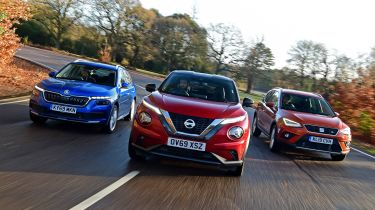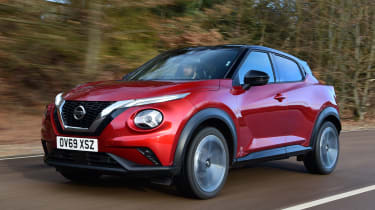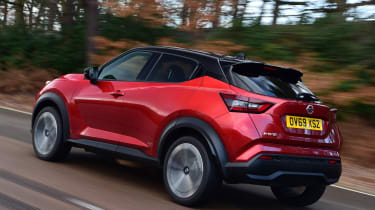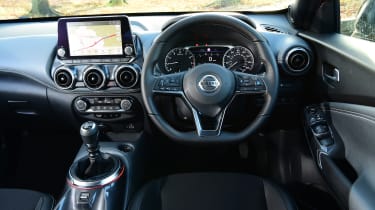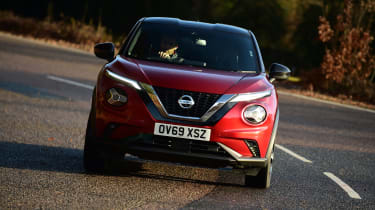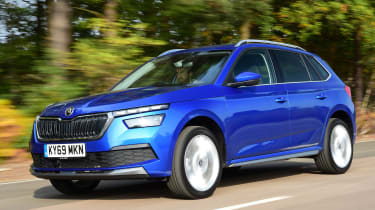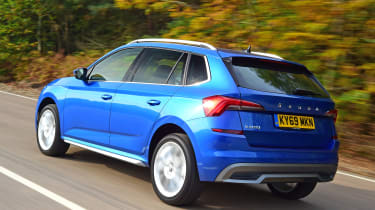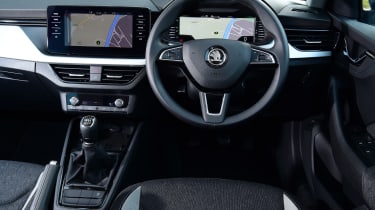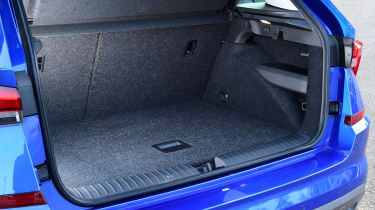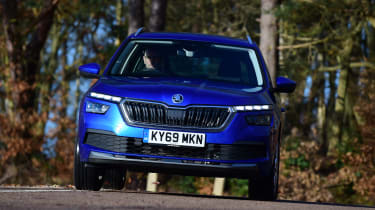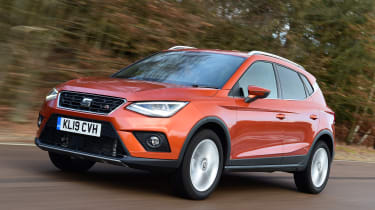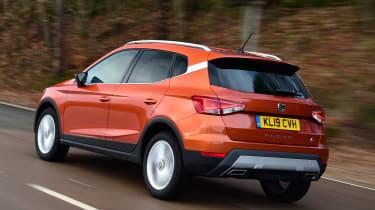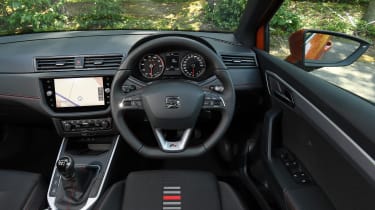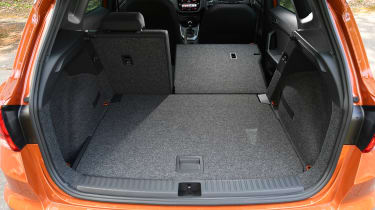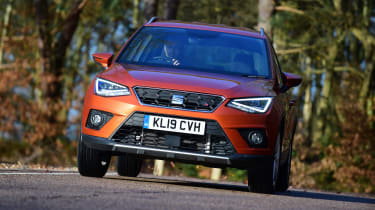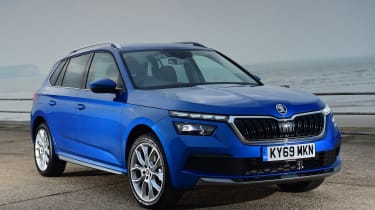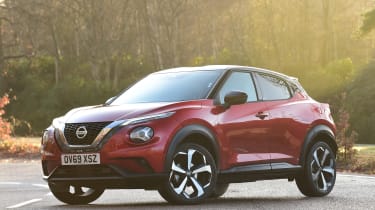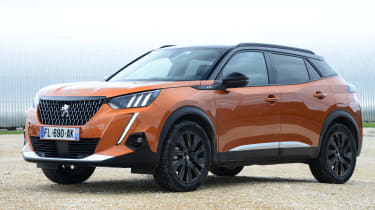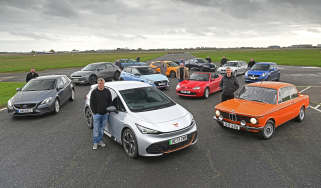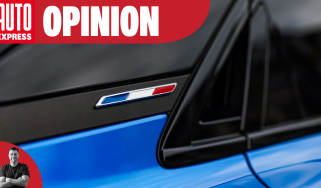Nissan Juke vs Skoda Kamiq vs SEAT Arona
The new Nissan Juke squares up to the Skoda Kamiq and SEAT Arona in the battle for the supermini-SUV crown
Nearly 10 years on since the launch of the original Nissan Juke, there’s an all-new model that’s just arrived in Britain.
The first Juke kick-started the whole supermini-SUV segment; previously, this part of the market was mainly rugged small 4x4s, like the Suzuki Jimny. But the funky-looking Nissan proved that buyers wanted cars that had a bit more practicality than a supermini and the styling of an SUV, but without the larger dimensions.
• Best crossovers and SUVs on sale now
Other car makers saw the potential of the segment and in recent years the choice has expanded rapidly. Even just in the last few months we’ve been behind the wheel of several models new to the class, including the Skoda Kamiq, which won its first Auto Express group test. Equally, there are some established players, too. The SEAT Arona, which is the other car in this test, has been around since 2017, and has been a consistent presence at the top of the class.
Here we’ll find out what Nissan has done to bring its pioneering model up to date with today’s competition, and which of these three small SUVs makes the most sense for the most buyers.
Nissan Juke
| Model: | Nissan Juke 1.0 DIG-T 117 Tekna |
| Price: | £22,495 |
| Engine: | 1.0-litre 3cyl petrol, 115bhp |
| 0-60mph: | 11.4 seconds |
| Test economy: | 41.2mpg/9.1mpl |
| CO2: | 118g/km |
| Annual road tax: | £145 |
This is the second-generation Nissan Juke; the Japanese brand has taken its time with its replacement for the big-selling original. Here we have a 1.0 DIG-T model in Tekna trim, which costs £22,495.
Used - available now
Design & engineering
The new Nissan Juke is one of the first models to use the Renault-Nissan-Mitsubishi Alliance’s CMF-B platform, which has been developed to bring improvements to lots of areas of the cars that will use it. It’s also engineered to allow electric powertrains as well as the latest autonomous safety tech and driving aids. Another model that uses this architecture is the latest Renault Clio, which won its first group test against the well established Ford Fiesta and SEAT Ibiza.
At 4,210mm long and 1,800mm wide, this new Juke is bigger than the old model, but it shares some design touches with the original version, such as the bubble-like headlights and exaggerated wheelarches.
As is common in this class of car, the Juke uses a three-cylinder turbocharged petrol engine. The Nissan’s 1.0-litre unit has 115bhp and 200Nm of torque, which is very similar to the 113bhp and 200Nm from the 1.0-litre unit in its rivals.
Our test model had a six-speed manual gearbox, driving the front wheels only. Cars in this class might have SUV styling, but owners seldom, if ever, take them off road, so there’s no need for four-wheel drive. It’s rare in this class and neither rival here has it, nor do they need it, because it adds unnecessary weight.
The Juke’s interior is well put together and there are some good-quality materials in certain places, but hard plastics in others, while cheap-feeling buttons and controls mean the cabin doesn’t seem as classy as its rivals’. While all three models have some low-rent materials inside, the Juke’s more elaborate cabin design can’t hide them as effectively.
Standard equipment on this Tekna model includes LED lights, cruise control, 19-inch alloys, a 360-degree camera, blind-spot assist, heated seats and an eight-inch touchscreen infotainment system with smartphone connectivity and sat-nav.
Driving
Nissan’s 1.0-litre engine has quite a few things in common with the units in its rivals. It’s quiet at low revs and doesn’t sound unpleasant even when pushed harder. It’s also happiest in the middle of the rev range, where it develops a decent 200Nm of torque.
But even with slightly more power, the Juke feels underpowered and lethargic next to the Kamiq and Arona. We recorded a 0-60mph time of 11.4 seconds in the Juke, which was two seconds behind the Kamiq and 2.4 seconds off the Arona. Its in-gear results were poor, too: it went from 30-50mph in fourth in 7.0 seconds, yet it took the Skoda and SEAT just 6.0 and 6.4 seconds respectively to do the same. The Nissan covered 50-70mph in top gear in 16.2 seconds, while the Skoda needed 11.9 seconds and the SEAT 13.1 seconds, despite shorter gearing in the Juke.
Part of the Juke’s poor performance is down to the gearbox. The engine holds its revs too long when you change gear, resulting in lumpy shifts unless you really take your time, and the shift action itself is rubbery and vague, unlike its rivals’ more precise shifts. The steering is well weighted, but there’s no feel and it’s not as accurate as the set-ups in the others.
Yet the Juke’s biggest problem from behind the wheel is its ride. It is unacceptably poor on British roads, constantly shuffling and vibrating over every kind of surface. It deals with speed bumps well, but any other imperfections are an ordeal, because they crash into the cabin and you’re forever being thrown around in your seat. Body control and grip are good – the Juke is nearly as agile as the Arona – but these factors are largely irrelevant in this class.
Practicality
The Juke has an adjustable boot floor and folding rear seats, but like the Kamiq and Arona, it misses out on a sliding rear bench, which is fitted to some other rivals. It has a fixed luggage space of 422 litres, which is still excellent: it’s larger than the Skoda and SEAT’s 400-litre capacities. Fold the seats down and there’s a little less room than in the Skoda, though, and the boot opening is narrower than the Kamiq’s. There are 1,305 litres in total with the rear seats down, which is 90 litres less than you get in the Skoda. SEAT doesn’t list a figure for the Arona in this configuration.
The moveable boot floor means you can choose between a slightly deeper boot and a flatter floor when the rear seats are folded, though.
Ownership
Safety is a strong point for the new Juke. It scored the full five stars in tests by Euro NCAP, and is fitted with lots of handy equipment as standard. This Tekna model gets parking sensors, a reversing camera, lane-keep assist, AEB and even blind-spot assist as standard, so it’s the best-equipped model here when it comes to safety.
Nissan came 11th in the makers’ chart of our Driver Power 2019 ownership survey, which was a bit behind Skoda’s fifth but ahead of SEAT’s 14th.
Running costs
The Juke returned 41.2mpg on test and will cost £1,675 per year to fuel. The Kamiq achieved 45.3mpg, which is £1,523 a year at current petrol prices, and the Arona recorded 41.4mpg, which works out at £1,667 annually. These figures are all good and prove a three-cylinder petrol unit is a solid choice of engine in this kind of car.
Insurance costs are similar in all three cars, but the Nissan is still the most expensive. It costs £380 to cover our example driver, whereas it would be £363 in the Skoda and £335 in the SEAT.
Testers’ notes
“Alongside the manual gearbox in our test Juke, there’s the option of a dual-clutch automatic just like the DSG transmission available on its rivals in this test. It costs £1,400, though.”
Skoda Kamiq
| Model: | Skoda Kamiq 1.0 TSI 115 SE L |
| Price: | £21,980 |
| Engine: | 1.0-litre 3cyl petrol, 113bhp |
| 0-60mph: | 9.4 seconds |
| Test economy: | 45.3mpg/10.0mpl |
| CO2: | 116g/km |
| Annual road tax: | £145 |
The Juke has a lot to live up to thanks to its well known name, but the Kamiq has an even tougher task: starting from scratch as a totally new car for Skoda. It’s got what it takes, as our current class favourite, though. In SE L form it costs £21,980.
Design & engineering
The Kamiq sits on the Volkswagen Group’s MQB architecture in its construction, which the Arona also uses. This platform is used in many other models, including Skoda’s Scala, and allows the use of the group’s 1.0-litre engine, found in Audis, SEATs, VWs and Skodas.
The three-cylinder motor is turbocharged and has 113bhp and 200Nm of torque, which is just below the Nissan’s 115bhp, but the Kamiq is the lightest model of the three, with a kerbweight of 1,158kg.
An option called Sport Chassis Control (£495) is available on the Skoda, which adds selectable driving modes and adaptive dampers, so you can change how firm the suspension is by altering the driving setting. This option is a little pricey, but it’s rare to see on a car in this class, although the standard suspension set-up is well balanced and delivers good ride quality and stable handling.
There’s not much visual flair in the Kamiq’s cabin. This is true of the Arona as well, and the build quality is good. There are some cheap-looking and feeling plastics in some areas, so you can tell where costs have been cut, but the large infotainment display gives the Skoda SUV a modern feel.
Our SE L car comes with a 9.2-inch touchscreen with sat-nav, Android Auto and Apple CarPlay functionality, plus AEB, lane-keep and blind-spot assist. On the options list there are a few interesting extras, including a powered tailgate (£400), LED headlights (£1,050) and wireless smartphone charging (£235). The Juke and Arona offer much more limited options ranges, but a greater number of trim levels.
Driving
The Kamiq’s strength when it comes to the driving experience is that it balances each key area very well. While it’s not outstanding in any single area, the Czech model is good at pretty much everything.
Firstly, the ride quality is about right: there’s enough firmness that body roll isn’t an issue in fast corners, but it still smooths out rough sections of tarmac and it’s calm on most roads. It’s soft enough to absorb potholes at low speed, although the set-up isn’t perfect, because there’s a bit of vibration at motorway speeds, but nowhere near as much as in the Juke. Wind and road noise are acceptable, so longer trips aren’t out of the question at all.
Plus, while it’s not quite as sharp to drive as the Arona, it’s satisfying enough from behind the wheel. There’s plenty of grip and its composure in corners means you can carry speed on country roads. The steering is light and doesn’t have enough feedback, but it’s more precise than the Nissan’s.
The Kamiq was the fastest car here in our in-gear acceleration tests. It was more than a second quicker than the Juke from 30-50mph in third gear, taking 4.2 seconds, which was also 0.1 seconds faster than the Arona. It went from 50-70mph in fifth gear in 8.9 seconds, again ahead of its SEAT sibling (which recorded 9.4 seconds) and well ahead of the sluggish Nissan (which needed 12 seconds).
The 1.0-litre engine is just as quiet at idle as it is in the SEAT Arona, and it never sounds harsh or unpleasant in the cabin, even at high revs. It has a pleasant thrum, in fact, and while you need to keep it at around 2,000rpm to make use of its maximum torque of 200Nm, it’s good to drive in a relaxed way.
The gearbox has a light throw, but it’s precise and mechanical enough to be satisfying to use. The light clutch means it’s no trouble around town, either.
Practicality
With its 400-litre boot with the rear seats up, and 1,395 litres of space with them folded, the Kamiq is very practical. It’s a little behind the Juke’s 422 litres, and it matches the SEAT’s 400 litres, so all three score well here.
There’s more than enough room for adults to sit comfortably in the rear seats, because there’s lots of headroom and legroom. There’s also enough light and the comfortable seats are easy to access through the rear doors. Yet while the Skoda is impressive in this area, it’s not bigger by a large margin; both rivals are spacious, too. A tight turning circle of 10.1 metres means parking the Kamiq is easy, especially because the steering is very light and visibility is good.
Ownership
EURO NCAP awarded the Skoda five stars out of five when it was tested recently, scoring very well in the Adult Protection category. Standard safety kit includes six airbags, AEB, blind-spot assist and lane-keep assist. Apart from the reversing camera, which costs £300, it’s about on par with the Juke for safety in this sense.
Skoda has scored highly in many of our Driver Power surveys over the years, and finished fifth in 2019. Nissan came 11th, while SEAT was 14th, so the Skoda is likely to be a solid ownership proposition.
Running costs
The Skoda and SEAT models are fitted with the same engines, but with an CO2 emissions rating of 116g/km, the Kamiq sits in the 27 per cent bracket for Benefit-in-Kind (BiK) tax contributions.
With CO2 emissions of 114g/km, the Arona is in the 26 per cent category. The Juke is also in the 27 per cent class, with emissions of 118g/km.
• Best car leasing deals available this year
These figures mean standard-rate taxpayers will contribute £1,175 this year in BiK for the Skoda, £1,140 for the SEAT and £1,203 for the Nissan.
Testers’ notes
“A relatively large 50-litre fuel tank means the Skoda Kamiq has a range of nearly 500 miles, based on our test economy figures. That’s a bonus if you’re making longer trips”
SEAT Arona
| Model: | SEAT Arona 1.0 TSI 115PS FR Sport |
| Price: | £22,155 |
| Engine: | 1.0-litre 3cyl petrol, 113bhp |
| 0-60mph: | 9.0 seconds |
| Test economy: | 41.4mpg/9.1mpl |
| CO2: | 114g/km |
| Annual road tax: | £145 |
The Arona has been a top car in this class since it was launched in 2017, and despite being the oldest model here it’s still a strong contender. In FR Sport trim the SEAT costs £22,155 with the 1.0-litre 113bhp engine and a manual transmission.
Design & engineering
This engine is shared with the Kamiq, so the Arona has the same 200Nm of torque at 2,000rpm. The Juke has an identical maximum torque figure, but in that car’s engine it’s delivered lower down, at 1,750rpm.
The SEAT also has a six-speed manual gearbox and front-wheel drive – four-wheel drive isn’t available. At 4,138mm long and 1,780mm wide, the Arona is the smallest model here, but as we’ll see, that doesn’t impact on its practicality. The MQB chassis on which it sits means it has a great basis not just for interior packaging, but also for ride and handling.
FR and FR Sport models come with an extra called SEAT Drive Profile, which adds selectable driving modes. There’s Normal, Sport, Eco and Individual options, the latter offering a customisable setting where you can alter the steering and throttle response – but there are no adaptive dampers available, so you can’t change the level of comfort. These sportier trim levels also feature a different suspension set-up to other versions, to improve body control.
The Arona’s cabin is smart, with a clean and modern look that will really appeal to some people but others will find a bit dull. Build quality is good and there are enough good-quality materials in key places that it feels classy, mainly down to the design.
There are very few options available on the Arona, and to get more kit you need to choose a higher trim level – even metallic paint comes included, so the list price is pretty much what you’ll pay. Standard equipment on this FR Sport model is decent, but it’s a shame certain features are missing: there’s no reversing camera, lane-keep or blind-spot assist tech available at all, nor can you add keyless go. What you do get is 18-inch alloys, adaptive cruise control, LED lights, a digital instrument cluster and an eight-inch touchscreen infotainment system with 3D sat-nav mapping and smartphone connectivity.
Driving
The SEAT Arona remains one of the best-handling cars in this class, and it combines this with good ride quality.
The steering is a lot like it is in the Kamiq: it’s light and precise but doesn’t offer much, if any, feel or feedback. There’s plenty of grip, and with the FR Sport trim’s sportier suspension, the SEAT resists body roll more than its Skoda cousin. This gives you more confidence to carry speed into corners, yet it’s not so stiff that comfort is an issue. The Arona doesn’t glide over bumps in the road, and you’ll notice harsh movements coming into the cabin every so often, but on the whole it’s comfy enough, and it’s certainly a lot more composed and smoother than the Juke.
The gearshift is light but has a reasonably short throw and a mechanical feel, so it’s satisfying to use, just like in the Skoda. The 1.0-litre engine is quiet at low revs, so the Arona remains pretty refined at normal speeds, and you’ll only hear wind and road noise at higher speeds. Add some more revs and you can hear a thrummy three-cylinder engine note.
Performance is a strong point here, too. The 113bhp engine carried the Arona from 0-60mph in nine seconds flat in our straight-line tests, which was the quickest here, and while the SEAT was slightly behind the Skoda in our in-gear tests, it’s not noticeably slower on the road.
The driving position could be better, though. Taller drivers might find that there’s not enough adjustment, especially in the steering column, to find a comfortable position behind the wheel. The seats could be more comfortable, too.
Practicality
Despite its smaller footprint compared with its rivals, the SEAT still matches the Skoda’s boot space, at 400 litres. Both are 22 litres behind the Nissan here, but all three cars have decent luggage capacity.
Visibility is good, and the light controls mean the Arona is easy to drive and park, even in tight spaces.
The rear seats are big enough for adults, but only just. A long trip in the back might cause some aches and pains for taller passengers, but it will be roomy enough for kids to be comfortable. There’s no issue with headroom, either, because adults can just about sit up straight in the back. Interior storage is okay, with a large cubby in front of the gearlever for your phone, which is useful when you’re using Android Auto or Apple CarPlay via the USB port there.
Ownership
You get six airbags and autonomous braking as standard in the Arona, but there’s no lane-keep assist or blind-spot monitoring, so it lags behind its newer rivals in this area. You can’t even add them as options, because they’re just not available with this trim level. The higher-spec Xcellence gets blind-spot assist, though.
SEAT’s dealers came in 19th place in our Driver Power 2019 survey, which was ahead of Nissan’s 28th position, but behind Skoda’s 10th-place finish.
Running costs
Our depreciation experts say the Arona has the lowest residual values here. After three years or 36,000 miles, it’s predicted to retain 44.8 per cent of its cost when new, which is a drop of £12,241 in that time to a price of £9,914.
The Juke holds 50.5 per cent, a loss of £11,144 to a price of £11,351. Finally, the Skoda sits in between the others, with a residual value of 48.1 per cent, which means it sheds £11,405 for a final value of £10,575.
Testers’ notes
“A tyre repair kit is included as standard on the Arona, but you can pay £110 to get a space-saver spare wheel. It’s one of the only options you can add with the SEAT.”
Verdict
First place: Skoda Kamiq
The Skoda is a clear winner here because it has the widest range of ability. It’s comfortable enough most of the time and nearly as good to drive as the Arona, while also having more room for passengers, good in-gear performance and low running costs. It has the best infotainment of the bunch, too, and running costs will be low. Value for money is high for all of these reasons, so the Kamiq stays at the top of the class.
Second place: SEAT Arona
Even though it’s been on sale for a while now, the SEAT Arona is still a very strong contender. Its infotainment and interior aren’t quite up to the standard of the Skoda here, but it’s a match for the Nissan, and just about every other aspect of the driving experience is better than the newcomer: it’s fun to drive, comfortable enough and easier to live with. It’s practical and has all the kit you’d want, too.
Third place: Nissan Juke
The new Nissan Juke is a disappointment, mostly because of its unacceptably harsh ride. Poor performance, an unpleasant manual gearbox and a high price hurt its appeal further, but it’s not without merit. It’s spacious inside, especially the boot, and there’s lots of standard kit, particularly safety gear. The engine is quiet and it’s a significant step on from its predecessor in terms of interior quality and infotainment.
Worth waiting for?
Peugeot 2008
Due: 2020Price: from £20,150Engine: 1.2-litre 3cyl, 128bhp
Peugeot's latest 2008 SUV will arrive in the UK early this year. It’s an all-new model with distinctive styling and a fresh interior, plus new engine options, including an all-electric version. It’ll be priced competitively with its rivals here.
Figures
| Skoda Kamiq 1.0 TSI 115 SE L | SEAT Arona 1.0 TSI 115PS FR Sport | Nissan Juke 1.0 DIG-T 117 Tekna | |
| On the road price/total as tested | £21,980/£25,790 | £22,155/£22,155 | £22,495/£23,640 |
| Residual value (after 3yrs/36,000) | £10,575/48.1% | £9,914/44.8% | £11,351/50.5% |
| Depreciation | £11,405 | £12,241 | £11,144 |
| Annual tax liability std/higher rate | £1,175/£2,349 | £1,140/£2,281 | £1,203/£2,405 |
| Annual fuel cost (12k/20k miles) | £1,523/£2,539 | £1,667/£2,778 | £1,675/£2,792 |
| Insurance group/quote/road tax cost | 12/£363/£145 | 12/£335/£145 | 14/£380/£145 |
| Servicing costs | £342 (2 years) | £384 (2 years) | £209/£289 (min/maj) |
| Length/wheelbase | 4,241/2,651mm | 4,138/2,566mm | 4,210/2,636mm |
| Height/width | 1,531/1,793mm | 1,543/1,780mm | 1,595/1,800mm |
| Engine | 3cyl in-line/999cc | 3cyl in-line/999cc | 3cyl in-line/999cc |
| Peak power/revs | 113/5,000 bhp/rpm | 113/5,000 bhp/rpm | 115/5,250 bhp/rpm |
| Peak torque/revs | 200/2,000 Nm/rpm | 200/2,000 Nm/rpm | 200/1,750 Nm/rpm |
| Transmission | 6-speed man/fwd | 6-speed man/fwd | 6-speed man/fwd |
| Fuel tank capacity/spare wheel | 50 litres/repair kit | 40 litres/repair kit | 46 litres/repair kit |
| Boot capacity (seats up/down) | 400/1,395 litres | 400 litres/N/A | 422/1,305 litres |
| Kerbweight/payload/towing weight | 1,158/556/1,200kg | 1,189/521/1,200kg | 1,199/368/1,250kg |
| Turning circle | 10.1 metres | 10.6 metres | 11.0 metres |
| Basic warranty (miles)/recovery | 3yrs (60,000)/3yrs | 3yrs (60,000)/2yrs | 3yrs (60,000)/3yrs |
| Driver Power manufacturer/dealer pos. | 5th/10th | 14th/19th | 11th/28th |
| NCAP: Adult/child/ped./assist/stars | 96/85/80/76/5 | 95/80/77/60/5 | 94/85/81/73/5 |
| 0-60/30-70mph | 9.4/9.5 secs | 9.0/9.2 secs | 11.4/11.4secs |
| 30-50mph in 3rd/4th | 4.2/6.0 secs | 4.3/6.4 secs | 5.3/7.0 secs |
| 50-70mph in 5th/6th | 8.9/11.9 secs | 9.4/13.1 secs | 12.0/16.2 secs |
| Top speed/rpm at 70mph | 120mph/2,400rpm | 118mph/2,300rpm | 112mph/2,500rpm |
| Braking 70-0/60-0/30-0mph | 48.0/33.7/12.5m | 51.6/35.1/8.2m | 51.9/32.1/11.8m |
| Noise outside/idle/30/70mph | 68/43/67/73dB | 68/52/65/73dB | 67/42/62/72dB |
| Auto Express econ. (mpg/mpl)/range | 45.3/10.0/498 miles | 41.4/9.1/364 miles | 41.2/9.1/417 miles |
| WLTP combined mpg | 42.8-47.1mpg | 43.5-47.1mpg | 46.3mpg |
| WLTP combined mpl | 9.4-10.4mpl | 9.6-10.4mpl | 10.2mpl |
| Actual/claimed CO2/tax bracket | 144/116g/km/27% | 158/114g/km/26% | 158/118g/km/27% |
| Airbags/Isofix/park sensors/camera | Six/yes/yes/£300 | Six/yes/yes/no | Six/yes/yes/yes |
| Auto box/lane-keep/blind spot/AEB | £1,250/yes/yes/yes | £1,080/no/no/yes | £1,400/yes/yes/yes |
| Clim./cruise ctrl/leather/heated seats | Yes/y/£1,280*/£250 | Yes/yes/no/yes | Yes/yes/synthetic/yes |
| Met paint/LEDs/keyless/pwr tailgate | £595/yes/yes/£400 | Yes/yes/no/no | £575/yes/yes/no |
| Nav/digital dash/DAB/connected apps | Yes/yes/yes/yes | Yes/yes/yes/yes | Yes/no/yes/yes |
| Wireless charge/CarPlay/Android Auto | £235/yes/yes | Yes/yes/yes | No/yes/yes |
